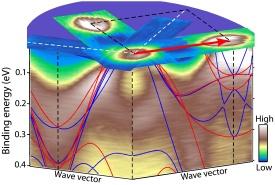

11/30/2009

The physical characteristics of superconductors, such as the disappearance of electrical resistivity at very low temperature, are well known. Yet when it comes to the fundamental mechanism that drives such behavior, particularly for the recently discovered class of ‘high-temperature’ superconductors, many open questions remain. Researchers from Tohoku University's Advanced Institute for Materials Research (AIMR) along with international collaborators1 have now revealed the significant role of interactions between electrons at different electronic states in the superconducting properties of the iron-based ‘pnictide’ superconductors.
The iron-pnictide superconductors, discovered just last year, share many commonalities with the closely related and well-known copper oxide-based superconductors (the ‘cuprates’). Both material classes have a complex two-dimensional layered structure that forms the basis for their superconductivity, and both begin to superconduct at relatively high temperatures (near 50 K).
The high-energy electrons responsible for superconductivity fill certain energy states at the top of what is known as the ‘conduction band’. These states can be plotted in three dimensions as a ‘Fermi surface’ that describes the crystal’s electronic properties in relation to the symmetry of the crystal lattice and the occupation of various energy levels. Fermi surfaces can be a single object, such as a sphere, or an arrangement of small unconnected shapes.
Using an ultrahigh-resolution photoemission spectrometer at Tohoku University, which allowed the electronic states to be resolved in fine detail, the researchers studied the relationships among the individual parts of the complex arrangement of Fermi surfaces in a pnictide superconductor (Fig. 1). They observed that the interaction between small Fermi surfaces — called nesting — is strong for this class of superconductors. “Our study has definitely established that Fermi surface nesting is an essential and universal feature for superconductivity in the pnictides,” explains Takashi Takahashi who led the research team.
Pnictide superconductors with strong interactions were found to have a higher superconducting transition temperature than those exhibiting weak interactions. The researchers also found that Fermi surface nesting plays a much stronger role in the pnictides than the cuprate superconductors, even though the underlying mechanisms of superconductivity are related.
According to Takahashi, based on this discovery of important differences between pnictides and cuprates, further studies of samples with different crystal structures are needed to determine precisely which electronic states lead to strong nesting and high transition temperatures. Ultimately, he adds, “by searching for new superconductors in which the Fermi surface nesting condition is well satisfied, we may able to find superconductors with higher transition temperatures.”
Terashima, K., Sekiba, Y., Bowen, J.H., Nakayama, K., Kawahara, T., Sato, T., Richard, P., Xu, Y.-M., Li, L.J., Cao, G.H., Xu, Z.-A., Ding, H. & Takahashi, T. Fermi surface nesting induced strong pairing in iron-based superconductors. Proceedings of the National Academy of Sciences 106, 7330–7333 (2009). | article
This research highlight has been approved by the authors of the original article and all information and data contained within has been provided by said authors.